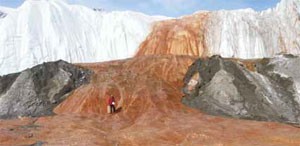Getting Lifeblood from a Stone

By Michele Cervi
Cut off from traditional sources of sustenance, the oldest forms of life on Earth are surviving on a diet of rocks and minerals. Geomicrobiologists -- one part Earth scientist and one part life scientist -- have discovered thriving bacteria in underground rocks and trapped beneath glaciers. Cut off from sunlight, this microbial life cannot rely on photosynthesis to produce food. So, how are these single-celled organisms surviving?
Survival of the Extremist
A Welsh research team conducted experiments with ground-up rocks containing minerals, such as quartz and basalt, to which they introduced microbes. When the mixture was heated, it produced hydrogen as the temperature increased. The microbes then ate the hydrogen to survive.
While the Welsh experiment replicated the high-temperature, high-pressure underground environments present deep within the Earth, geomicrobiologists also have found microbial life that adapted to extreme cold. Blood Falls, Antarctica, earned its name from iron-rich water that seeps from an underground lake and turns a rusty red as it meets the oxygen in the outside air. The underground reservoir formed when a glacier moved over the salty lake, trapping the water and its contents beneath the glacier and shutting out the supply of oxygen. Research teams at Blood Falls have discovered that in the absence of oxygen, the microbes within the sub-glacial lake are surviving off the dissolved iron and sulfates in the water.
Researchers from Oregon State University have shown that microbes discovered in icy lava tubes subsist on iron contained within the olivine in the lava rock. Olivine also is found in volcanic rocks on Mars.
Microbial life that thrives in such extreme conditions suggests that, in the search for life beyond Earth, we may need to expand our thinking on the elements required to sustain life. "If it can survive below this glacier, why not below the ice cap on Mars and on Europa?" asks Jill Mikucki, lead researcher at Blood Falls. Could more microbes flourish in other inhospitable environments? A project called the Census of Deep Life, spearheaded by a microbiologist at Oregon State University, will attempt to quantify and classify microbes that live within the earth and at the deepest depths of the oceans.
Classroom Discussion
- What are other types of microbes? How do they differ from one another?
- Do you think rocks and minerals on other planets might contain microbial life? Why?